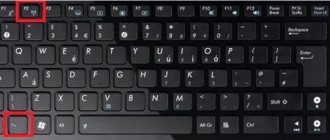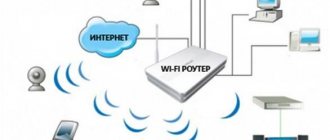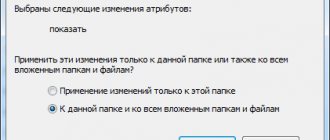Possible solutions to problems
One of the simplest tips would be to reset your device to factory settings. Indeed, in this case, no third-party intervention is required - all settings and resets are done at the software level. But this trick will only work if the smartphone’s malfunctions are caused only by software and clogged memory. After resetting the settings, and in frequent cases erasing the content, the device turns on like new.
But there are cases when malware, in other words, viruses, penetrate the device’s file system. These “parasites” are capable of interfering with the key files responsible for restoring and resetting the Android operating system, changing them and, in some cases, even deleting them. This is where the main problems begin, because the only correct solution is to flash the smartphone. Below we describe the main method of flashing devices from some manufacturers and the answer to the main question: “How to flash Android via Recovery?”
Where can I find the firmware and why should I reinstall it?
Installing firmware via TWRP may be necessary if:
- Errors constantly appear in the Android operating system.
- Applications do not open.
- Many programs from the Play Market do not work.
- The phone itself reboots or turns off.
- It gets stuck on the OS loading screen.
- It works slowly or lags a lot when flipping through desktops.
- You decided to try a different version of Android.
- You are not satisfied with the functionality of the stock (official) firmware.
- The OS does not meet the system requirements of the smartphone.
Don't just download Firmware or run TWRP Recovery for no reason. If done incorrectly, the phone will simply break. If you don't like the interface or want to change the button design, it's better to install a new launcher.
To update the operating system through Recovery, you need to download it from somewhere. It can be done:
- On the official website of the manufacturer. Find your device model there. There should be a "Support" or "Drivers and Utilities" section.
- On the Android application developer resource.
- On specialized services where users post custom or official OSes. For example, on the 4pda forum.
- Online. Type “download firmware for [smartphone model]” into any search engine.
Firmware must be accompanied by a description and instructions. If it indicates that the archive is being downloaded through Recovery mode, you can download it.
Do not use software that is not designed for your phone. If you try to load it with an incompatible OS, it will stop working.
What is “Recovery” and what is it eaten with?
Many immediately give up their positions and throw out the white flag, rushing to contact service centers. But any experienced user will tell you that this is not worth doing. After all, you can save yourself extra nerves and money by just following the simple steps from these instructions.
“Recovery” is a smartphone software based on the Android OS, which is something like a “BIOS” on a PC. That is, using “Recovery” you can completely reset your smartphone to factory settings, you can also install operating system updates and simply flash it. When purchasing in a store, the user most often receives a device with an -menu, which is slightly limited in functionality and will not allow you to successfully flash the operating system.
If we talk about “custom” (translated from English custom - “made to order”) “Recovery”, then it will allow you to more fully “communicate” with the phone system, make backup copies of firmware and restore them, as well as make a more complete and deep reset of the device.
How to enter "Recovery"
To flash a device through “Recovery”, you must first get into this very menu. This couldn’t be easier to do, especially since on many devices the input combination is exactly the same. So, if the smartphone has a physical central button or a “Home” button (most often found in older Samsung and LG devices, but it can also appear in more modern devices), you need to hold down the “Home” buttons with the gadget turned off. and “Volume +”, then, without releasing them, press the power button.
The device will turn on in the desired mode. If you have a more modern device without a physical Home button, you need to repeat the process described above, but using only the Volume + button and the Power button. If the desired result was not achieved, you should refer to the extended list of ways to enter the “Recovery” menu for different manufacturers.
What else will you need?
In order to understand how to reflash Android, you first need to download the firmware for your device. Most often, firmware files are hidden from public view for security purposes and to protect the manufacturer’s data. That is why ordinary users create backup copies of their operating systems and form databases of stock firmware from them, links to which can be found on specialized sites. It is the firmware file itself, located in the archive with the *.zip extension, that you will need to understand how to restore Android using Recovery.
There are also times when you are tired of the old stock firmware and want something new. That is why there are always craftsmen who create custom firmware, “cutting out” the unnecessary from them or, conversely, adding something new. In such cases, it will not be possible to use the standard “Recovery”, and here those custom CWM Recovery (ClockWorkMod Recovery) or TWRP (TeamWin Recovery Project) come to the rescue.
Installing the recovery function
To flash the firmware, the phone must have a recovery function installed (for example, Android System Recovery 3e). Rooting provides the user with the necessary level of access to perform administrative tasks on their device. Recovery offers the tools needed to actually perform these tasks. Every Android smartphone comes with a built-in recovery feature, but its functionality is usually very limited, so you will need a third-party Recovery to perform additional operations.
The installation process for this feature is usually not very different on different device models. After installing the recovery, you can proceed to the next step.
Now that the recovery feature is installed, you can perform additional operations, including flashing the firmware or installing an application from a ZIP file. The procedure is not much different for most ROMs, although some firmware require a special approach. Since the process may vary for some ROMs, it is recommended to find detailed instructions specifically for your firmware through a search engine.
Installing CWM Recovery or TWRP
It is not necessary to install Recovery on Android via a computer; most often, on the contrary, it is easier to use the stock one. All you need to do is download the necessary file, again located in an archive with the *.zip extension, and place it on the external flash card of your smartphone.
After that, going to the stock “Recovery”, you need to select the “Apply update from external storage” item and in the list that opens, select the same file with the custom “Recovery”. After confirming your choice, the installation process will begin, after which the device will prompt you to reboot. The process is complete.
Updating or flashing Android using ADB sideload
This option should be used when the stock recovery does not have an option to flash the OS and the over-the-air update does not work. This is done as follows:
- Before you start working with adb, you need to download basic drivers.
- Then Andro is downloaded >
- The next step is to launch the Windows terminal (cmd), after which you need to go to the directory with unpacked adb.
- Then the command “ adb sideload filename.zip ” is launched - instead of filename you must specify the name of the firmware file!
Then press the Enter key - the installation process of the new version of the operating system from the Flash card will begin. This way you can install both updates and full stock firmware on your phone.
How to flash Android via Recovery
Moving directly to the process of installing the firmware itself, I would like to say that all unofficial files of the Android operating system, created directly by users of certain devices, should be installed at your own peril and risk. If, however, the decision is made to install a non-native version of the software, you should make sure that the firmware is “written” specifically for the phone that you plan to reflash.
If we are talking about stock firmware, then you should not bother installing CWM Recovery or TWRP. All manipulations that need to be done are limited to downloading the factory firmware file and placing it on an external memory card. After this, the process is similar to installing custom “Recovery”. That is, you need to go to the stock “Recovery” menu, select “Apply update from external storage”, then specify the firmware file directly and confirm the action. After the process is completed, you need to take one more step that will help avoid freezes and glitches when turning on and operating the device. Immediately after the firmware is completed, you need to select the “Wipe data/factory reset” menu item and confirm the action. This will clear information about previous software and files that were present on the device before the firmware process.
After completing these steps, you must select the “Reboot system now” menu item. The device will reboot and the process of setting up the smartphone from scratch will begin. If the switching process takes a long time and the device logo “hangs”, it’s worth remembering whether the settings reset item was performed after flashing.
Why do you need custom recovery?
Its installation is necessary to expand the functionality of the smartphone. After all, the “native” recovery menu does not allow you to use all the functions of the phone - in particular, uploading third-party firmware is not possible. In addition, they have limited or no backup functionality at all, which results in the risk of losing all information from the phone.
And therefore, the best solution for Android owners would be to install an alternative TWRP (in the picture above) or CWM . This allows you to solve many problems:
- install unofficial firmware;
- install unofficial updates and patches to the OS;
- connect the device to a PC as a storage device;
- fully manage backups: backup all or part of the firmware, save and delete backups, perform recovery;
- connect your smartphone to your PC in developer mode using ADB;
- check the status of the device and the functionality of all modules;
- reset battery operation statistics;
- format and repartition a memory card or the built-in memory of a smartphone and much more.
The full list of functions of the custom version is simply huge, and depends directly on the software version and the type of smartphone.
Custom versions of Android
How to flash Android via Recovery is, in principle, clear. It remains to figure out what to do with OS versions written directly by device users. The answer is simple: the process needs to be repeated, performing the same manipulations in custom “Recovery”. The only difference is that the firmware file itself can now be placed not only on an external memory card, but also on the internal memory of the device. This adds convenience in the event that a flash card is simply missing. In this case, you will have to select the “Apply update from internal storage” option.
It is also worth noting that in CWM Recovery and TWRP the “Wipe data/factory reset” item has been replaced with two separate items: “Wipe data” and “Wipe cache”. After installing “Android” through “Recovery” (namely, the custom version), you need to select the “Wipe Dalvik cache” sub-item in the modified ClockWorkMod or TeamWin menu, which will significantly increase the chances of successfully turning on the device with the new operating system.
Setting up the device after flashing the firmware
The initial startup of the device may take a long time, which is due to automatic system optimization. After a few minutes, the updated Android will launch and offer the first setup. After starting the OS, you need to select a language, set the time and connect to the access point.
Despite the fact that the Android system is distinguished by its stable operation, there are often cases when it is necessary to flash the smartphone. This is necessary in case of unstable system operation, frequent freezes or other system lags. The main reason for such troubles is the firmware installed on the phone. The situation can be corrected by reinstalling the software. This can be done using a computer. But what to do if you don’t have a PC at hand and how to install firmware on Android from an SD card?
Restoring stock firmware
If you didn’t like the custom firmware or didn’t take root, there is always the opportunity to return everything to its place. Many people ask the question: “How to restore Android through Recovery, namely the stock version?” The answer lies in the point above. Roughly speaking, returning everything to normal occurs in the same way as making the initial changes.
All you need to do is download the firmware from the manufacturer to a flash card or internal memory, then select the appropriate “Recovery” menu item and do a complete reset of settings/content. In principle, nothing complicated.
Recommendations
It seems that understanding how to flash Android via Recovery is not so difficult. But if some points are unclear, or you are not confident in your knowledge, it is better not to get involved with such processes. But even if something doesn’t work out, you can always restore the device’s firmware through the corresponding menu item. The main thing is to make a backup copy before flashing Android via Recovery. To do this, you will need a custom “Recovery” and a little patience, because the process of backing up the firmware takes a lot of time.
If something goes wrong, you can always turn to knowledgeable people. At least an authorized service center will definitely help you. The main thing is not to lose heart and move forward confidently. This is the only way to achieve any results. Good luck with the flashing!
Anyone who takes the first steps in learning the Andro firmware procedure >
How to flash an Android device using factory recovery
Almost every device running the Android OS is equipped by the manufacturer with a special recovery environment, which provides, to some extent, including ordinary users, the ability to manipulate the internal memory of the device, or more precisely, its partitions.
It should be noted that the list of operations that are available through the “native” recovery installed in devices by the manufacturer is very limited. As for the firmware, only official firmware and/or updates are available for installation.
In some cases, through factory recovery, you can install a modified recovery environment (custom recovery), which in turn will expand the ability to work with firmware.
At the same time, it is quite possible to carry out the main actions for restoring functionality and updating the software through factory recovery. To install the official firmware or update, distributed in *.zip , follow the following steps.
- To install the firmware you will need an installation zip package. Download the required file and copy it to the device’s memory card, preferably to the root. You may also need to rename the file before manipulation. In almost all cases, the appropriate name is update.zip
- Boot into the factory recovery environment. Methods to access recovery vary for different device models, but they all involve using combinations of hardware keys on the device. In most cases, the desired combination is “Volume -” + “Power”.
With the device turned off, hold down the “Volume-” button and, while holding it, press the “Power” key. After the device screen turns on, you need to release the “Power” button and continue to hold down “Volume-Volume” until the recovery environment screen appears. To install the software or its individual components into memory partitions, you will need the main recovery menu item – “apply update from external SD card”, select it.
Universal Titanium Backup
This program is one of the first of its kind, and today it is considered one of the most universal for data backup and recovery. To carry out such a procedure, of course, you will need the program itself, and you also need root rights. The latter are needed because we need access to system folders.
Once the program is installed, it will ask for superuser rights, which we grant it. It should be noted that when working with this program you need to be extremely careful. If you do not know what exactly a certain function does, then it is better to abandon it. In general, experts recommend strictly following the instructions for using the program.
How to flash a device through a modified recovery
Modified (custom) recovery environments have a much wider range of capabilities for working with Android devices. One of the first to appear, and today a very common solution, is the recovery from the ClockworkMod team - CWM Recovery.
Installing CWM Recovery
Since CWM recovery is an unofficial solution, you will need to install a custom recovery environment on your device before use.
- The official way to install recovery from the ClockworkMod developers is the ROM Manager Android application. Using the program requires root rights on the device.
Download, install, launch ROM Manager.
On the main screen, tap the “Recovery Setup” item, then under the “Install or update recovery” inscription, tap the “ClockworkMod Recovery” item. Scroll through the list of device models that opens and find your device.
The next screen after selecting the model is the screen with the “Install ClockworkMod” button. Make sure that the device model is selected correctly and press this button. The recovery environment begins downloading from the ClockworkMod servers.
After a short time, the required file will be downloaded completely and the installation process of CWM Recovery will begin. Before you start copying data to the device’s memory section, the program will ask you to grant it root rights. After permission is received, the process of recording the recovery will continue, and upon completion, the message “Successfully flashed ClockworkMod recovery” will appear confirming the success of the procedure.
For devices built on the MTK hardware platform, the SP Flash Tool application is used.
Lesson: Flashing MTK-based Android devices via SP FlashTool The most universal method, but at the same time the most dangerous and complex, is flashing recovery via Fastboot. The steps taken to install recovery using this method are described in detail at the link:
Firmware via CWM
Using a modified recovery environment, you can flash not only official updates, but also custom firmware, as well as various system components represented by cracks, add-ons, improvements, kernels, radios, etc.
It is worth noting that there are a large number of versions of CWM Recovery, so after logging in on different devices you can see a slightly different interface - background, design, touch controls may be present, etc. In addition, some menu items may or may not be present.
The examples below use the most standard version of the modified CWM recovery. At the same time, in other modifications of the environment, when flashing the firmware, items are selected that have the same names as in the instructions below, i.e. A slightly different design should not cause concern to the user.
In addition to design, the management of CWM actions differs in different devices. Most devices use the following scheme:
- Hardware key “Volume+” – move one item up;
- Hardware key “Volume-” – move one item down;
- Hardware key “Power” and/or “Home”—confirms the selection.
- We prepare the zip packages necessary for installation into the device. We download them from the Global Network and copy them to a memory card. Some versions of CWM can also use the device's internal memory. Ideally, the files are placed in the root of the memory card and renamed using short, clear names.
Enter CWM Recovery. In most cases, the same scheme is used as for entering the factory recovery - pressing a combination of hardware buttons on a switched off device. You can also reboot into the recovery environment from ROM Manager.
Before us is the main recovery screen. Before you start installing packages, in most cases, you need to “wipe” the “Cache” and “Data” sections - this allows you to avoid many errors and problems in the future.
- If you plan to clear only the “Cache” partition, select the “wipe cache partition” item, confirm the deletion of data - select “Yes – Wipe Cache”. We wait for the process to complete - the following message will appear at the bottom of the screen: “Cache wipe complete”.
Let's move on to the firmware. To install the zip package, select “install zip from sdcard” and confirm your choice by pressing the corresponding hardware key. Then select the item “choose zip from sdcard”.
A list of folders and files available on the memory card opens. We find the package we need and select it. If the installation files were copied to the root of the memory card, you will have to scroll to the bottom of the list to display them.
Before starting the firmware procedure, recovery again requires confirmation of awareness of your own actions and understanding of the irreversibility of the procedure. Select “Yes – Install ***.zip”, where *** is the name of the package to be flashed.
Possible difficulties
During the installation of an alternative Recovery Mode, in particular CWM, various difficulties and errors may arise. Which of them are the most common and how to solve them?
CWM Recovery does not recognize the memory card
CWM makes it possible to update your phone using an archive. When opening Recovery, the user sees a message that the flash card cannot be mounted. After installing another card, even with less memory, the problem disappears. The reason lies in the Windows system itself. The fact is that it diverges from card formatting standards. To ensure formatting is performed in accordance with the specification of SD/SDHC/SDXC flash cards, and not just in standard form, it is recommended to use specialized software, for example, SD Formatter.
The SD Formatter program allows you to correctly format the SD card
CWM does not see the internal memory of the device: problem solution
When the recovery files are located on the internal memory, and therefore can only be recovered from there, a problem may arise. When you connect the USB cable to the PC and enable USB Debugging, the program reports that the Android device is not detected and you need to enable USB Debugging.
To solve this problem:
- Connect the device as a camera, not a storage device. If there are other options available, choose them.
- Install universal drivers.
- Find a more suitable Recovery program for your device.
Recovery menu doesn't work
If when you launch the alternative recovery mode (volume + Home button or power) a picture appears with a lying robot, then the recovery was flashed, but when you restarted the device it was overwritten by the stock Recovery.
The problem is solved as follows.
- Before flashing the Odin3 program, you need to uncheck the Auto restart checkbox and disconnect the cable after flashing. From Download mode on the device, go to recovery mode by pressing the volume up + home screen + power keys in sequence and hold them until the recovery menu appears. So you should get into the custom recovery menu anyway.
- In it, select Reboot system now and then check Yes. This action will overwrite the stock recovery with a custom one and the “No command” error will be corrected.
Flashing a new Recovery mode means acquiring new functionality. Firmware methods vary in complexity, but ironically, the simplest of them require access to Root, that is, device administrator rights. When choosing a firmware method, you need to be guided by the phone model first. Rom Manager is not suitable for all devices. For HTC, the FastBoot method is more suitable, while for Samsung it would be more correct to choose Odin.
What is CWM recovery
CWM is a type of modified “recovery mode” with expanded capabilities compared to the official version, which is used by electronics manufacturers. Installation restrictions have been lifted, allowing owners to install third-party firmware and other modifications - kernels, patches or applications.
If CWM recovery is available, users should take a more careful approach to the choice of installed firmware and add-ons. Since incorrect actions will lead to software damage to the device, sometimes without the possibility of lifting it at home or in a service center.
CWM recovery sections
- Reboot system – restart the system.
- apply update.zip from sdcard – install the archive with the image/update located on the memory card.
- wipe data/factory reset – deleting user information.
- wipe cache partition – clears the cache in the internal memory section.
- install zip from sdcard – installing an archive from a memory card.
- backup and restore – saving an image of the entire system or only a specific partition. Restoring a previously created image or partition.
- mounts and storage – contains items for mounting the system, drives and other partitions. More cleaning and formatting tools.
- advanced – additional tools. The section contains items for clearing the Dalvik cache, rebooting recovery, and more.
CWM recovery sections of the Touch version
reboot system now – reboot the device.
install zip – section with options for choosing to install a system image, update, or install from external memory.
wipe data/factory reset – this section allows you to erase user data. Often necessary to install a new mod or to reset settings and reconfigure the system.
wipe cache partition – delete a cache partition.
backup and restore – this section contains items on saving images of the system/partition, as well as returning a backup in case of unsuccessful manipulations with the system or in case of a rollback from one firmware to another.
mounts and storage – contains settings for mounting and cleaning partitions.
advanced – includes the functions of going to recovery or bootloader, turning off the device, clearing the cache, etc.
Installation methods for CWM recovery
If you have root rights, installing CWM is possible using the Rom Manager program or other analogues that allow you to set a custom recovery mode. However, this method is extremely undesirable, since it often leads to freezing during the boot process of the device or other problems. The reason is the lack of compatibility of the program with a specific device. Therefore, it is better not to use this installation method unless there is precise evidence that the method works.
The best and proven installation method is via fastboot. To install, you need to enter the appropriate fastboot mode on your phone, connect the device to the computer and flash CWM to the recovery section. In this case, the bootloader on the device must first be unlocked. A detailed description of the installation can be found individually for each model, taking into account the distinctive features of the file system, platform, etc.
Firmware Clockworkmod Recovery via Fastboot mode
This option is more reliable and can safely be called classic. But it requires a direct connection of the smartphone to the PC via USB, installation of a specialized Android SDK Platform Tools and “firmware” drivers.
The way to update the recovery is to replace the Recovery.img located in a special section of the device’s memory. Fastboot mode , into which you must put the device before connecting it to the PC.
It is important to note that this option is not available for all types of smartphones, as it requires unlocking the bootloader . It cannot be unlocked on all devices, and some devices are missing some sections.
But if you were able to unlock the bootloader, and your phone meets all other requirements, then the sequence of actions is as follows:
- Download Andro >
Important! While flashing the firmware, do not disconnect the device from the cable - otherwise the recording may fail and subsequently turn it into a “brick”.










